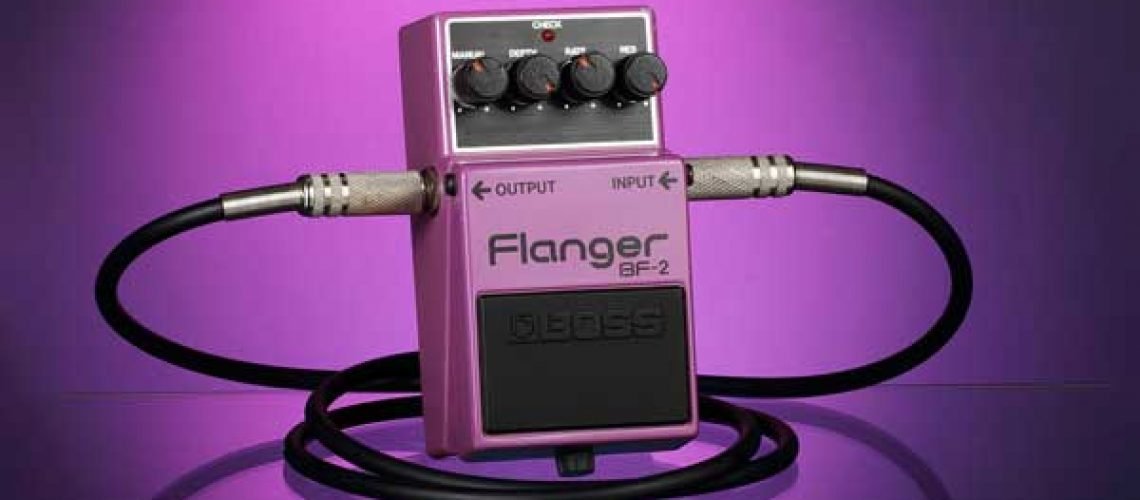A question I get asked a lot is “What’s the difference between phasers and flangers?” Both of these devices introduce peaks/notches into an audio signal’s frequency spectrum, causing the effect they produce to sound somewhat similar. This article will explore the differences in the way these tools process audio, and how you can tell them apart by ear.
How Phasers and Flangers Process Audio
A phaser uses all pass filters to introduce peaks and notches into an audio signal’s frequency spectrum. Many phasers allow you to control the number of peaks/notches applied, and the frequencies they’re affecting. On its own, a set of peaks/notches isn’t very impressive. This is why phasers usually come with an LFO that modulates the center frequencies of the peaks/notches over time.
A flanger duplicates its incoming audio signal and delays the duplicate to create peaks and notches in the audio signal’s frequency spectrum. The delay time is often a small period of below 20ms that is continuously changing via the use of a modulation device like an LFO. The result is a sweeping comb filter that creates peaks and notches that are related to each other in a linear harmonic series. To further clarify what this means, a flanger will produce a prominent pitch as the comb filter’s peaks sweep up and down the frequency spectrum. Phasers don’t tend to exhibit this characteristic because the peaks they create aren’t related to each other in a linear harmonic series.
Flanging is actually a particular type of phasing. Originally, phasing referred to the tape flanging effect that many artists were using in the Psychadelic records of the 1960s. The reel of tape that contained the material you wanted to apply the flanging effect to would be record to two identical tape machines simultaneously. These two tape recordings would then be recorded to a third tape machine, but the audio engineer would apply gentle pressure to the flange of one of the playout reels to slightly delay it over time. The flange refers to the playout reel’s rim, which is where this effect gets its name. It wasn’t until later on that this effect was developed into the form of an accessible foot pedal.
From a design standpoint, the difference between modern phasers and flangers is in the way they go about applying peaks/notches to the frequency spectrum of an audio signal. Phasers generate a set of peaks/notches using all-pass filters, whereas flangers create a set of peaks/notches by duplicating the incoming audio signal and modulating the delay time. Flangers also typically apply a greater number of peaks/notches to the frequency spectrum of a sound than phasers do.
Because the input signal of a flanger is doubled, you’ll probably want to use a gain control plugin to attenuate the level of your audio signal after you’ve applied the effect.
How to Tell Phasers and Flangers Apart by Ear
People who grew up playing and recording guitar may be familiar with the sound of phasers and flangers, since they’re commonly available as foot pedals. The effect they create is different enough that many folks can tell them apart by ear.
If you can’t tell phasers and flangers apart yet, don’t worry. Over time, and through your experience using these devices, you’ll be able to differentiate them from one another. Flangers typically sound like the jet engine of a plane during takeoff and landing, while phasers often sound like a laser beam from a sci-fi movie.
The following video by 3rdStoryChemist demonstrates the effects of phasing vs. flanging. The great thing about this video is that it demonstrates these effects using various different device settings. The flanger used in the video is a Boss BF-2 Flanger, but if you’re interested in purchasing this unit, there’s a newer version called the Boss BF-3 Flanger. The phaser being used is an Electro Harmonix Small Stone Phase Shifter, which now comes in a more compact version called the Electro-Harmonix Nano Small Stone Phase Shifter.
Blue Cat makes both a free phaser plugin, and free flanger plugin that I’m particularly fond of. Some other options include the Waves MetaFlanger that’s capable of creating both phasing and flanging effects, as well as Universal Audio’s MXR Flanger-Doubler.
I want to invite you to join me in the Black Ghost Audio group on Facebook; it’s full of producers currently working in the music industry who are more than happy to help you improve your productions. Leave a comment below if you have any questions regarding this article. Your feedback is always appreciated, and we’ll take it into account when we publish future articles.




